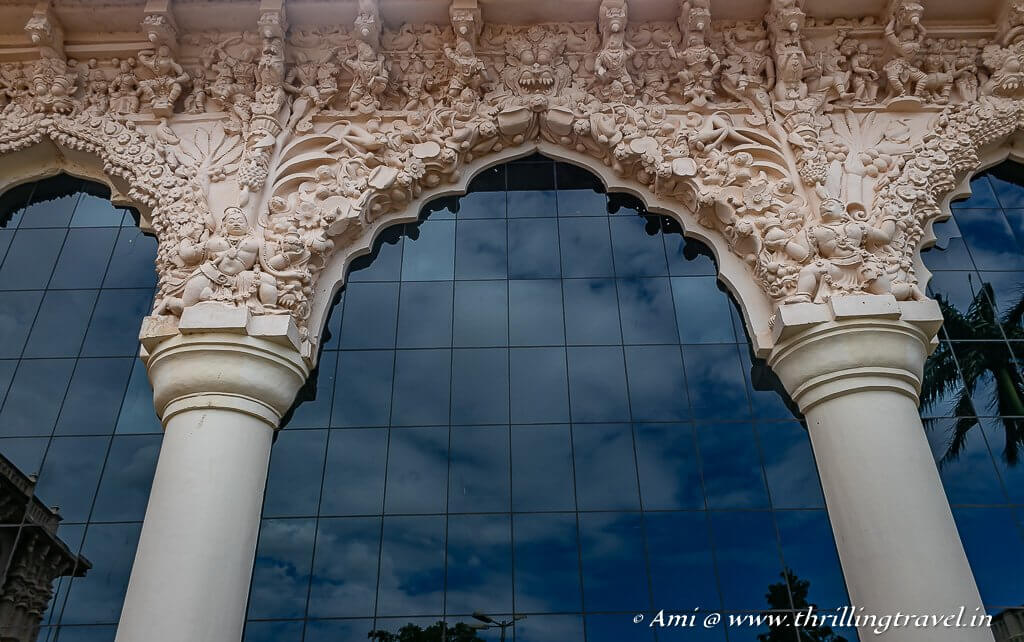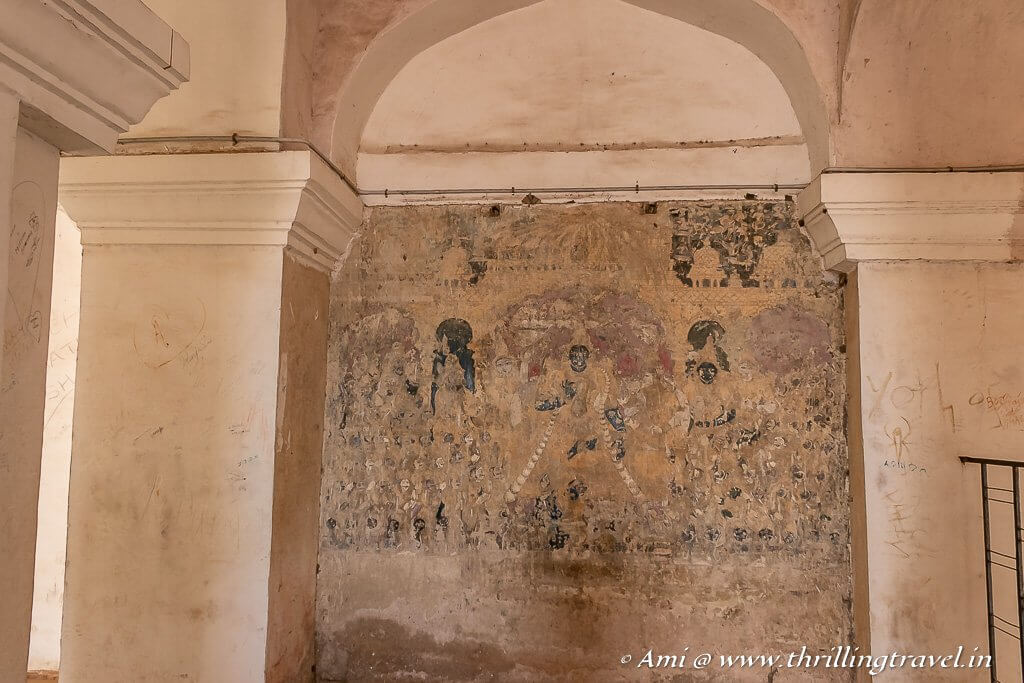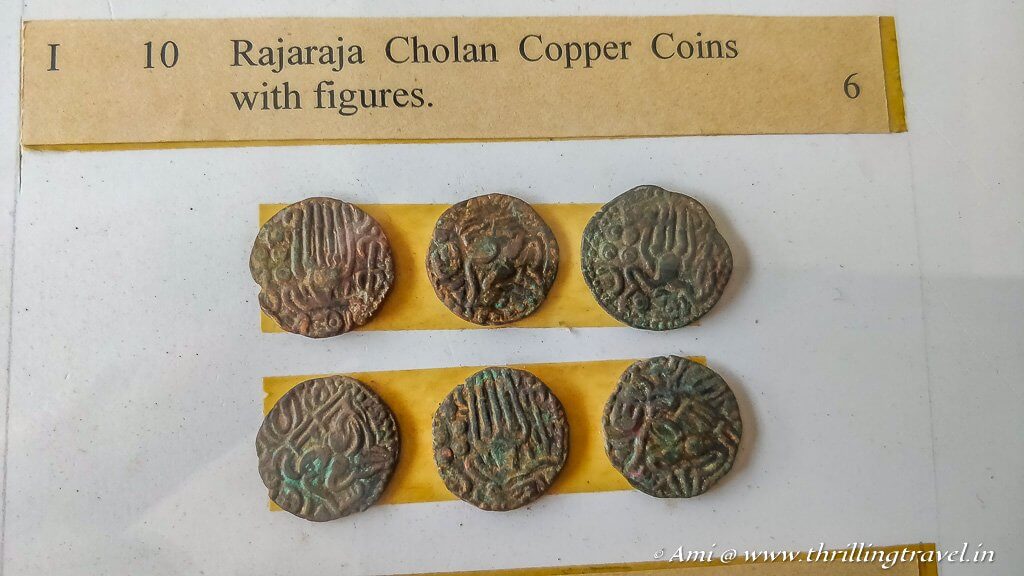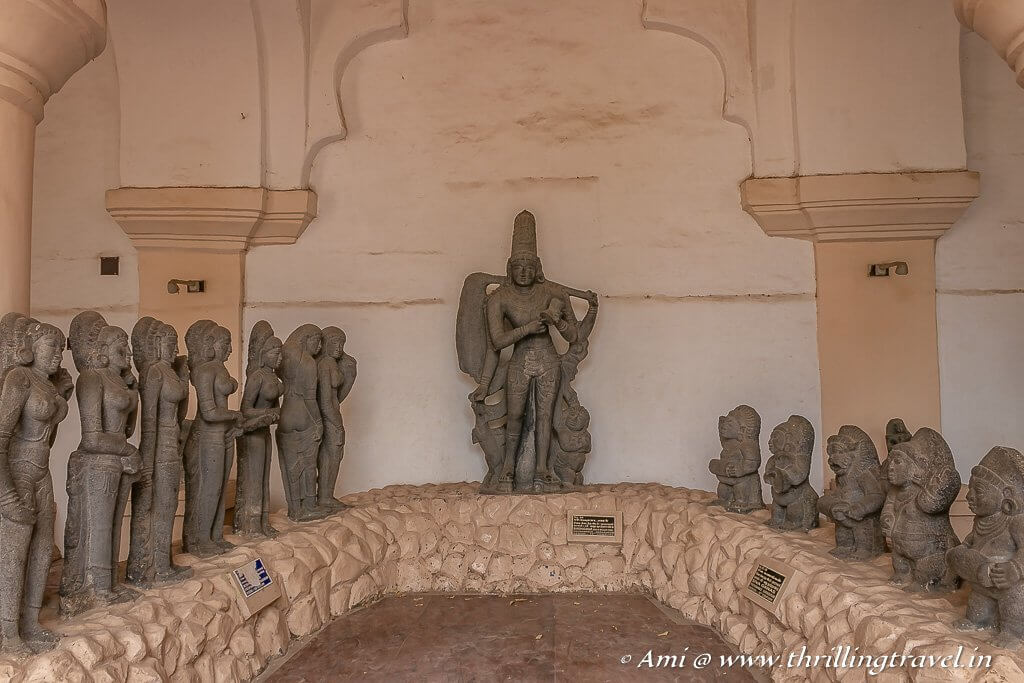What are the names that come to your mind when I say places to visit in Thanjavur? Is it is just the Thanjavur Temple? Well, that is the first and the most important Tanjore attraction but the 2nd one on this list is likely to be the Thanjavur Palace. My first brush with the Thanjavur Maratha Palace was a part of my Golden Chariot Journey but it was just like a cursory glimpse. Even with those few moments, I was dazzled by this palace in Thanjavur.and that had me to return to explore it in depth. Now it is your turn to be bewitched by it through this virtual tour of Thanjavur Palace.

The palace in Tanjore is one of the few Maratha palaces in South India. It is home to one of the oldest libraries in Asia. Besides this, the Thanjavur Palace Museum is a host to several ancient treasures while the Durbar Hall is home to vibrant sculpted wonders. This guide to Thanjavur Palace will treat you to the entire story that these archaic walls shared with me.
Contents
- 1 History of Thanjavur Palace
- 2 Layout of Tanjore Palace
- 3 The Bell Tower of Palace of Thanjavur
- 4 Sangeet Mahal
- 5 Arsenal in the Palace of Tanjore
- 6 Art Gallery of Thanjavur Palace
- 7 Saraswathi Mahal Library
- 8 Sadar Mahal
- 9 Sarjah Mahdi
- 10 How to reach Thanjavur Palace?
- 11 Where to stay in Thanjavur?
- 12 Best time to visit Thanjavur Palace
- 13 Travel Tips
- 14 Booking resources
History of Thanjavur Palace
The Thanjavur Aranmanai Palace (as called by the locals) might be referred to as a Maratha fort but it was originally built by the Nayaka kings in the 1530s. They soon, lost their hold on the kingdom to the Thanjavur Marathas. Known as the Bhonsales, the royal family made alterations and additions to the Nayaka palace. They continued to own the palace even during the British era, almost until the last King Shivaji of Thanjavur died.

The palace fell into disrepair until the tourism authorities turned their attention to it. Work has been ongoing and a fair bit of the palace has been restored.
Layout of Tanjore Palace

The original layout of Tanjore Palace might have been that of a fort. There are remains of a moat around the palace compound and some historical texts also, call the place Sivaganga fort. In fact, the palace is located in a region called Periya Kottai meaning “Big Fort”. The palatial compound has several sections that are spread across three courtyards. They include –
- The Bell Tower
- Arsenal
- Raja Raja Chola Art Gallery
- Saraswathi Mahal Library
- Raja Serfoji Memorial Hall
- Royal Museum of Thanjavur
- Durbar Hall
- Sangeet Mahal
- Sarjah Mahdi
Pro Tip: You will have to buy three different tickets to access the complete palace. The tickets are not expensive – in fact, they are as low as INR 5.

I managed most of these sections except for the Sarjah Mahdi and Sangeet Mahal. The first was a little off the path and I frankly, forgot about it. I was so lost in the images of what I had already seen. The 2nd – Sangeet Mahal was closed. I will share a little tidbit about it below – just in case it is open when you go.
The Bell Tower of Palace of Thanjavur
After collecting the first ticket, I walked through a palatial arch to a wonderous sight of a 7-storeyed tower. This served as the bell tower of Thanjavur Palace. It used to be taller but got destroyed by the forces of nature – thunder and lightening. Owing to its unusual architecture – wide arches around a rectangular column, it is known as a “Wide-holed Pavilion” or Maadamaaligai.

The Bell Tower was used to indicate time (hence, the locals also, called it Manikoondu). They say that there was a unique clock with a monkey striking a gong every hour. The clock was on top of the tower. Today, however, one can only enjoy the view of Thanjavur from the top. I am not sure if you are allowed in and frankly, there was no one around to ask either. The two times that I visited here, the doors to the top were locked. Local lores indicate that King Vijaya Raghava Nayak climbed up every noon to set his eyes on Ranganathaswamy Temple in Srirangam and pay his respects to the Gods.
Sangeet Mahal
This is a plain white building – opposite to the Bell Tower. As mentioned, it was closed. However, the exteriors are not what makes it unique. The auditorium is built by the Nayak kings in such a way that it does not echo any sound, allowing the musicians and dancers to perform flawlessly. Sadly I missed it – both the times – because it was closed.
Arsenal in the Palace of Tanjore

Enter through the gates of the palace and a temple-like structure greets you. Except that it is not a temple tower or a gopuram. It is actually an arsenal. It has been deliberately designed to look like a temple so that the invaders get confused. The Gooda Gopuram, as it has been called, is 8 floors tall. It is around 192 feet in height. Not only was it storage for weapons but it also, functioned as a watchtower. One of the levels was used for martial training.

In my order of exploration, a tour of the Arsenal Tower came in after the Art Gallery. However, since we are already virtually here, let’s go up the stairs to level one (the only one that is open). This is where I found a maze of arched passageways – possibly made to confuse the enemy. At one end, they seemed to lead up into hidden chambers and possibly even up the rest of the tower. The central passageway ended with faded murals on the wall. Now here is an interesting fact – there are hidden secret chambers in the Arsenal towers with acoustic properties. There is no access to them anymore but if rumors are to be believed, then whispers could be transmitted as a message to at least 3 floors above it.



Don’t exit as yet for there is something for you to see at the end. A huge skeleton of a whale. A faded signboard identifies it as a Baleen Whale who in its dead state washed up the shores of Tharangambadi beach in 1955. There is no information on how it got here. However, I do know how big the skeleton is – 92 feet ;-). The little balcony area of Level one is a great place to capture the looming tower.
Art Gallery of Thanjavur Palace

Called the Raja Raja Chola Art Gallery, this section is rich in every sense of the word. Not only are the exhibits priceless but the former durbar hall is too. Originally the main court of the Nayaks, the place will awe you with its stunning ceilings and wall sculptures. Right above the statue of Raja Serofji, are stuccos of various Indian deities while on both sides of the statue, you can see the Maratha crest. If you look closely at the picture of the ceiling, you will see a painting of a clock with a divine creature around it. Not sure, but maybe, there was a real clock here.


The bronze statues of Shiva, Parvati and various other deities certainly endorse the intricate craftsmanship of yester-years. Among the many that I enjoyed, I found this one of Shiva and Parvati’s marriage quite admirable. I love the details – check out the way he is holding the hand of his betrothed and how Parvati is being given away.

You got to check out the old coins in this Thanjavur Art Gallery – some dating back to 300 BC. I even found the coins from the earliest kingdom of Thanjavur – the Chola times.

The courtyard outside too, has some remains of the past. Like this fountain area and the little temple-like structure at the other end. At the base of the Arsenal tower, there are several stone exhibits that go back to 10th century and beyond. They have been arranged quite well to create a larger scene. This one of the Ganas (dwarfs) and the Rishis paying obeisance to Lord Shiva in his Bhikshadanar form (mendicant) was one of the highlights for me.


Saraswathi Mahal Library

Proclaimed as one of the most “remarkable libraries of India” by Britannica Encyclopedia, the Maharaja Serfoji’s Saraswati Mahal Library is the 2nd courtyard area of the Thanjavur Palace. You cannot miss it as its colorful facade will draw attention when you are on your way to the Bell tower. It was first established by the Nayakas and later the Thanjavur Marathas – especial Raja Serfoji added to its contents. It has more than 49,000 palm-leaf manuscripts and over 73,000 books. The contents range from the epics of Mahabharata and Ramayana to books on anatomy (complete with diagrams) and torture methods – mostly Chinese (gulp!). Some of these books cannot be found anywhere in the world.

Photography is not permitted here but you got to imagine this. If you ever get there, look for the Sabthartha Cintamani. This rare manuscript can be read in both directions. When read left to right, it tells you the story of Rama and in the opposite direction, tells you the tale of Krishna. Besides the titles. you can see the smallest books and scribblings on rice that can only be read under the magnifying glass.

The reception area and the ticket counter of the Saraswathi Mahal Library in Thanjavur are plastered with interesting art. The dual story template of the Sabthartha Cintamani continues here. What can you see in this picture – two animals hugging? An elephant? A Cow? Interesting …right?
Sadar Mahal

Courtyard number three – here we come. The Sadar Mahal actually consists of various parts – some not maintained as well. A series of arched passageways open into one big courtyard with a landscaped garden. At the far end of the courtyard is a huge empty arched corridor. A lone broken gate occupies one end of it and in between, you might find some abandoned pieces of art like a huge Tanjore doll. Looks like they might curate this area for more of these discovered treasures.

They say that there lies an underground tunnel somewhere here. I read somewhere that it is open but during my trip, I found no such secret gateway. The one that is supposed to be open is a smaller one but there is a larger one somewhere in Thanjavur palace that connects to the Brihadeeswarar temple. The passage is big enough for two horses to trot side-by-side.
In any case, let us get back to the other interesting facets of the Sadar Mahal.
Royal Palace Museum

This can be identified by the faded murals on the wall. The museum houses olden vessels, weapons and head gears used by the royal family in their heydays. Frankly, the museum was not very impressive, especially when you compare it to the Art and Bronze museum that I shared earlier. I think one of the main reasons was that the place itself was not so well maintained. The poor lighting added to the gloom of the ruins. Somehow, I found it difficult to appreciate the finer details of the exhibits. However, since I was here, I did a quick cursory tour of the same.
Raja Serfoji Memorial Hall
Right next to the Royal Palace Museum is the Serfoji Memorial Hall. Initially, it seemed like the same dingy atmosphere but it is better lit and more pleasant than its neighbor. This is where you will find photographs and paintings of the Royal family. Most of them belonged to Raja Serfoji and hence, the hall has been named after him. With time of the essence, I did a quick round here to move to something more intriguing that I happened to glance on earlier.
Durbar Hall of Thanjavur Palace

If there is a highlight or focal point of the Palace of Thanjavur, then it has to be the Durbar Hall. In simple terms, this was the court of the Kings. However, there is nothing simple about it. One sight of it can send you into a frenzy. And with me, that is exactly what happened.


Every inch of it displays either a painting or a fresco A wall painting of Raja Serfoji greets you from the throne. As you entered this royal arched area, the colorful ceiling takes your breath away. At the corner of that dome are carvings of deities.



Follow the dome down to the various pillars and you will see more of these carved beauties. These are not some random sculptures but are characters enacting scenes from the Ramayana and Mahabharata. Why, I even found the famous Draupadi Vastraharan scene staring down at me!
Every ceiling, every doorway had a different tale to tell. Pity I was out of time else I would have spent a lot more here just trying to decipher the meaning of each.
Sarjah Mahdi
I walked out in a daze, still thinking about the colorful Durbar Hall of Thanjavur Palace. I blame it on the hall for having forgotten the last place to visit in Thanjavur palace. The Sarjah Mahdi required me to walk in a different direction from the ticket window. The attraction is a line of five ornate balconies. Apparently the wood workmanship is exquisite. These are supposed to be the royal balcony.
Ah well, guess there has to be something left for next time. At least it leaves a hope, doesn’t it? That is it from me on this Thanjavur Palace Tour. Tell me, what was your favorite part of this tour? And are you tempted to get there in person? Here is a pin for you to share around and add to your own list of must-visit places in Tamil Nadu.






How to reach Thanjavur Palace?
- If you are traveling by Air, then the Trichy airport will be the closest for you. It is 61 km from the city of Tanjore and can be reached by car, bus or train
- Thanjavur has its own railway station with decent connectivity to the key cities of India.
- Roads to Thanjavur are pretty good. You can embark on a road trip from any of the cities in South India.
- Once in Tanjore, you can either hire an auto or a cab to get here.
Where to stay in Thanjavur?
- Thanjavur offers plenty of stay options. You can pick from moderately priced hotels to luxury hotels. Since we were here only for a day, we stayed in Hyders Park which is at the edge of the city. However, it is close to a lot of restaurants. The Tanjore palace and the Tanjore Temple are both within a 2 – 5 km radius.
Best time to visit Thanjavur Palace
- Thanjavur as a town, is pretty warm throughout the year. The weather is quite pleasant in winter – December to February. You could plan a visit then.
- Thanjavur Palace is open from 9 am to 6 pm every day. It does close for lunch between 1 pm to 2 pm.
Travel Tips
- The two times that I visited here, I did not find any guides. Nor did I find proper signage. Hence, just make sure you have this tour handy
- As mentioned earlier, there are three separate tickets to be bought. The main ticket is for INR 50 per adult. If you have a camera, you have to pay INR 30 for it. This ticket allows you access to the Saraswathi Mahal, Durbar Hall, the Bell Tower and Armoury area. If you wish to visit the other two museums, you will have to pay INR 5 per museum. This would be at the entrance of the respective museums.
- Plenty of walking to be done. Keep some water handy. There are enough restrooms around the place and a little away from the palace, you will find restaurants too.
Booking resources
- Booking.com has numerous options for your hotels in Thanjavur. You can use this link to check them out and book them
- If you use Amazon for purchasing your home and travel needs, do consider navigating to it through this link.
Disclaimer: This article includes affiliate links. This means that at no cost to you, I will receive a small commission if you purchase through my link. Thank you for supporting me with this.
Popularly referred to as a Restless Ball of Energy. My Mom refuses to entertain my complaints about my equally restless daughter & assures my husband that I was born with a travel bug.
I am a Post-Graduate in Marketing by qualification and a travel blogger by passion. Besides travel, I enjoy photography and if you don’t find me at my desk, I would be out playing badminton or swimming or just running. I believe in planning for every long weekend through the year. And when I cannot travel physically, I travel virtually through this travel blog. My travel stories have also, got published on various websites and magazines including BBC Travel, Lonely Planet India and Jetwings. I have recently published my first book – When Places Come Alive – a collection of stories that are based on legends, landscapes, art and culture of a place which is available in both ebook and paperback format.


Congratulations for this awesome post. I love the Indian palaces and Thanjavur Palace looks absolutely fantastic, it left me completely speechless. I see many similar features for decorations and ornaments as I saw when I visited Nepal. The Durbar(s) in Nepal is usually impressive as well. I would be interested to hear more about the architecture influences between India and Nepal.
The two have a lot of similarity in terms of design and influence – both being Hindus largely. However, Durbar Squares are largely wood while the south Indian style is a mix of limestone and granite. Check out the other places in South India and you will see this.
I can certainly see why you might return to the Thanjavur Palace more than once. The architecture and detailed stone work would keep me enthralled for many days. And such a variety of buildings side by side. That Bell Tower beside the painted facade is fascinating. So very cool that the arsenal was built to look like a beautiful temple. The Art Gallery building is a work of art all on its own. And the colourful tile work on the library is simply stunning. Good to know that guides and signs are scarce.
It is a good and a bad thing to have a guide absent. For one, you get a lot of freedom but on the other hand, you might not know what you are looking at!
What a beautiful palace. It never ceases to amaze me the architecture and interiors of the palaces, forts and temples in India. I had a trip planned for India this September which unfortunately now has to be moved. Good to know that there are no guides as I’d prefer to go learn more about the palace with someone rather than just wandering around aimlessly.
Like I mentioned, it might be a double edged sword to have no guides. While you get the freedom, you might not know what you are looking at. Hopefully, that is where my blog should come handy 🙂
Your articles make me return to India. I have been three times so far but still haven’t seen so many beautiful places. The architecture of this palace is stunning. I especially like detailed sculptures and wall paintings. Colors are breathtaking too. I hope to back to India one day and visit Thanjavur Palace also.
I live in India and still cannot get enough of these lovely structures. In fact, there is still so much unseen 😀
What a magnificent work of art…this Thanjavur Palace. But I am especially drawn to libraries so the colorful library was particularly interesting as one of the oldest in Asia. Especially when you talked about that manuscript that reads as Rama one way and Krishna the other way. And I can see why the Durbar Hall is also enticing, especially that Hallway. But the best architecture is the Arsenal Tower!
I could not read the script but it was amazing to see such a manuscript. I so hope you can get here to see it yourself.
Ive heard about Thanjavur palace before, but this is the first time I’m reading a legit blog about it. And i must say, i found this quite helpful and insightful. All the photos did make my travel virtually to Thanjavur for sure.
Thanks Arnav. It is often missed in a bid to visit the Thanjavur temple. Am glad though that this time I managed to get a detailed tour.
I loved the architecture of Thanjavur and I had been twice here when I was in school. But I missed this Thanjavur Palace and always visited that famous Tanjore temple with the famous bull. The Arsenal tower looks beautiful here and good to know that the pillars here are having acoustic properties. Many south Indian temples have pillars with acoustic properties which is really adorable. The colorful Stucco art in Art Gallery Hall is really enchanting. You have captured beautiful photos of this palace.
Thank you Yukti. I was lucky to have had a clear day that enhanced these structures. I do hope that next time you get to go beyond the temple and see this palace.
What a gorgeous palace! That is super useful to know that it shuts at midday too. I cannot imagine visiting somewhere like this without a camera, so I would happily pay extra for the privilege.
I am sure you will love capturing everything here. It is so gorgeous and worth the camera fee
I have been there in 2019, amazing place. There is one small theatre as well where they are playing the documentary on Thanjavur and its history.
Ah yes, there is a theatre but I missed it when I went. Either way, this is one amazing palace.